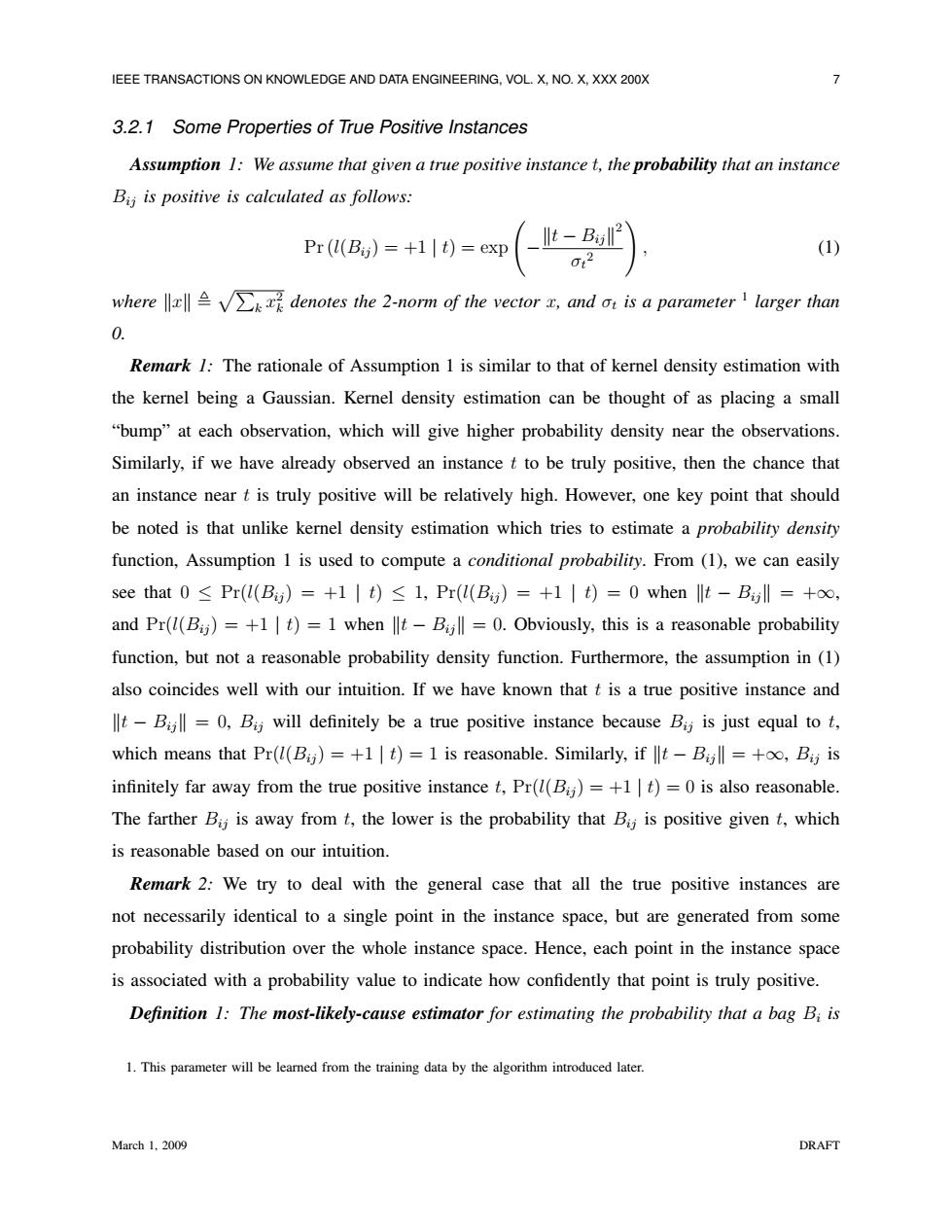正在加载图片...

IEEE TRANSACTIONS ON KNOWLEDGE AND DATA ENGINEERING,VOL.X,NO.X,XXX 200X 7 3.2.1 Some Properties of True Positive Instances Assumption 1:We assume that given a true positive instance t,the probability that an instance Bij is positive is calculated as follows: Pr(l(Bij)=+1|t)=exp llt-Bisll 042 (1) where denotes the 2-norm of the vector x,and a is a parameter larger than 0. Remark 1:The rationale of Assumption 1 is similar to that of kernel density estimation with the kernel being a Gaussian.Kernel density estimation can be thought of as placing a small "bump"at each observation,which will give higher probability density near the observations. Similarly,if we have already observed an instance t to be truly positive,then the chance that an instance near t is truly positive will be relatively high.However,one key point that should be noted is that unlike kernel density estimation which tries to estimate a probability density function,Assumption 1 is used to compute a conditional probability.From(1),we can easily see that0≤Pr(l(B)=+1|t)≤1,Pr(l(B)=+1|t)=0 when llt-Bl‖l=+oo, and Pr(l(Bj)=+1t)=1 when -Bjll =0.Obviously,this is a reasonable probability function,but not a reasonable probability density function.Furthermore,the assumption in(1) also coincides well with our intuition.If we have known that t is a true positive instance and llt-Bjl=0,Bj will definitely be a true positive instance because Bij is just equal to t, which means that Pr(l(Bij)=+1t)=1 is reasonable.Similarly,iflt-Bjll =+oo,Bij is infinitely far away from the true positive instance t,Pr(l(Bj)=+1t)=0 is also reasonable. The farther Bii is away from t,the lower is the probability that Bii is positive given t,which is reasonable based on our intuition. Remark 2:We try to deal with the general case that all the true positive instances are not necessarily identical to a single point in the instance space,but are generated from some probability distribution over the whole instance space.Hence,each point in the instance space is associated with a probability value to indicate how confidently that point is truly positive. Definition 1:The most-likely-cause estimator for estimating the probability that a bag Bi is 1.This parameter will be learned from the training data by the algorithm introduced later. March 1,2009 DRAFTIEEE TRANSACTIONS ON KNOWLEDGE AND DATA ENGINEERING, VOL. X, NO. X, XXX 200X 7 3.2.1 Some Properties of True Positive Instances Assumption 1: We assume that given a true positive instance t, the probability that an instance Bij is positive is calculated as follows: Pr (l(Bij ) = +1 | t) = exp − kt − Bijk 2 σt 2 ! , (1) where kxk , pP k x 2 k denotes the 2-norm of the vector x, and σt is a parameter 1 larger than 0. Remark 1: The rationale of Assumption 1 is similar to that of kernel density estimation with the kernel being a Gaussian. Kernel density estimation can be thought of as placing a small “bump” at each observation, which will give higher probability density near the observations. Similarly, if we have already observed an instance t to be truly positive, then the chance that an instance near t is truly positive will be relatively high. However, one key point that should be noted is that unlike kernel density estimation which tries to estimate a probability density function, Assumption 1 is used to compute a conditional probability. From (1), we can easily see that 0 ≤ Pr(l(Bij ) = +1 | t) ≤ 1, Pr(l(Bij ) = +1 | t) = 0 when kt − Bijk = +∞, and Pr(l(Bij ) = +1 | t) = 1 when kt − Bijk = 0. Obviously, this is a reasonable probability function, but not a reasonable probability density function. Furthermore, the assumption in (1) also coincides well with our intuition. If we have known that t is a true positive instance and kt − Bijk = 0, Bij will definitely be a true positive instance because Bij is just equal to t, which means that Pr(l(Bij ) = +1 | t) = 1 is reasonable. Similarly, if kt − Bijk = +∞, Bij is infinitely far away from the true positive instance t, Pr(l(Bij ) = +1 | t) = 0 is also reasonable. The farther Bij is away from t, the lower is the probability that Bij is positive given t, which is reasonable based on our intuition. Remark 2: We try to deal with the general case that all the true positive instances are not necessarily identical to a single point in the instance space, but are generated from some probability distribution over the whole instance space. Hence, each point in the instance space is associated with a probability value to indicate how confidently that point is truly positive. Definition 1: The most-likely-cause estimator for estimating the probability that a bag Bi is 1. This parameter will be learned from the training data by the algorithm introduced later. March 1, 2009 DRAFT